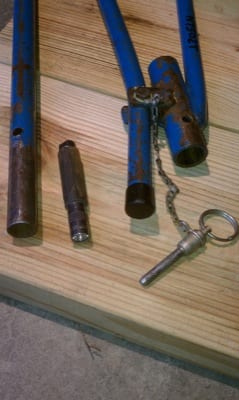North Carolina pilot Chip Davis used to struggle in the dark to get the towbar on the nosegear of his C172A, so he came up with his own solution.
 He started by noting that the collapsible towbar for Cessna, Beech, Piper, and many tailwheel aircraft has a T-handle made of 3/4-inch tubing.
He started by noting that the collapsible towbar for Cessna, Beech, Piper, and many tailwheel aircraft has a T-handle made of 3/4-inch tubing.
“A single AAA-cell Maglite wrapped with 8 inches of duct tape will fit snugly into the open end of the T-handle and provide light exactly where you need it,” he said. “Wrap the tape around the barrel of Maglite, being careful to remain clear of both end caps. Test for a snug fit and adjust as necessary. Then, just twist the exposed Maglite head to turn the flashlight on and off.”
He even included a parts list: One $60 AS&S 13-01540 Deluxe Cessna Towbar; one Maglite K3A036 Solitaire; and 8 inches of 2-inch wide Duct Tape.

I know I am an anal old curmudgeon, but “duck” tape instead of duct tape and “yolk” instead of yoke in print drives me CRAZY! And by the way, the article was about a flashlight not duct tape. And why this is news? OY!
Two items required in every mechanic’s tool box: Duct tape and WD40.
If it moves and isn’t supposed to, use the duct tape.
If it doesn’t move and is supposed to, use the WD40.
Jim Klick
Pitts S1S
Oops – guess I should have taped the flashlight to point towards the wheel! 🙂
Duck tape would come in really handy after a Quack-UP!!!!!!
What other uses? Okay… let’s say you’re off fly (he-he, no pun intended) fishing in some grizzly infested wilderness. An’ yer plane happens to smell like salmon. You can use duct-tape to recover the fuselage and tail feathers that thar bear done ripped to shreds, while you was down on the river. ‘course the repair is only good enough to get yer b-hind back to civilization. Then ya gots to have it done all FAA & proper like.
On my D-18-S Trigear Beech, the auto cycle valve on the deicing boots failed, filling the left wing boot, which had an anurisum blow out. We landed at Vericruz Mexico. I Used duct tape to make repairs, using 12 3′ overlaping strips (Nose to Tail) over the blowout.
On cycling the boots the rest inflated in a normal manner. We continued the flight to San Andreus, Columbia without further incidence.
I was at an airshow 20 years ago in Lincon Il. when a AV8A Harrier landed on new asphalt. Needless to say the pilot blew big chunks of that asphalt up into the stabulators on the Harrier. After he taxied off and shut down the mechanic went out to the corn field right there at the airport and got a corn cobb off the ground. He used that corn cobb to fill in the leading edge of the stabulator on the Harrier. Then he put OD Green duct tape over that fix. The pilot and I were watch all this so I ask just what kind of a fix this was, that he was doing. His answer was: ” I promius this tape will be here on this here, aircraft if the pilot agrees to stay under 300 kts on the way back to base.’ So now I don’t use duct tape I use 300kts tape for all my repaires!
Mike
C 172 Pilot
I think that’s a great idea! When I was learning to fly this past summer, on all of my night flights I would have a hard time getting the C150 back in the hanger due to a lack of light, this is a great solution, of course now I have a Luscombe and no tow bar, but I will pass this on to my instructor!
Duck Tape! I would like to know what other uses where you can use Duck Tape on an airplane?
I use it to keep student pilot’s feet on the rudder pedals.
Nice, hmm I always thought it was Duct tape, as opposed to DUCK Tape which is for wrapping all those birds together after you shoot them down.